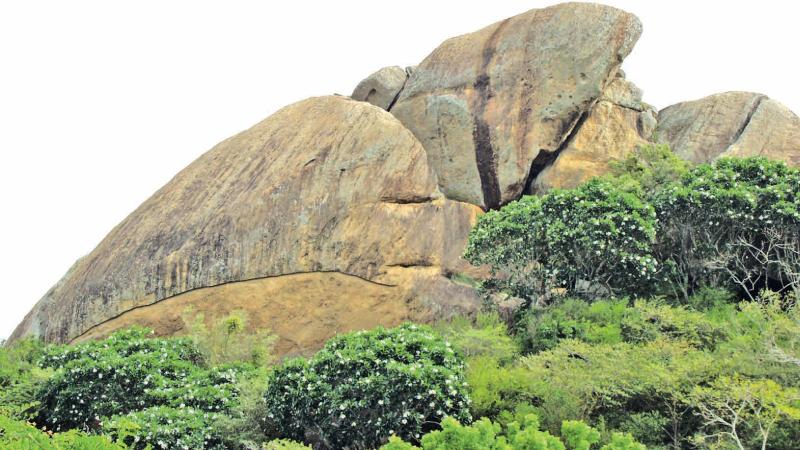
Anuradhapura was and is a great Buddhist capital. But it was not the place where Buddhism first overwhelmed the people of Sri Lanka. That honour goes to Mihintale, a rocky hill about seven miles (11 kilometres) East of Anuradhapura. For it was here, in 247 BC, that King Devanampiyatissa accepted Buddhism in his encounter with that first missionary of the Dharma.
Among the rock boulders on Mihintale are found some interesting caves and ponds. These caves no doubt represent the first dwellings of the meditative bhikkhus of the earliest period of Sri Lanka’s history of Buddhism.
Rajagirilena
 |
| Ruins around the Kaludiya Pokuna on Western slopes of the Mihintale range |
We visited the Rajagirilena hill and the Kaludiya Pokuna at Mihintale, two magnificent sites usually missed by the hundreds of visitors who throng Mihintale during the Poson season. Numerous are the ruins scattered around the Kaludiya Pokuna.
The Rajagirilena hill is a lower hill of the Mihintale range. Here the magnificent rock boulder, which has been converted into caves, forms the vast complex that would have sheltered hundreds of monastic bhikkhus.
The remains of monastic complexes indicate them to be the residential area for bhikkhus headed by Arahath Mahinda. These are natural caves covered in greenery, and entering them, one gets a feeling of calm and tranquility, savoured by the bhikkhus who lead an ascetic life.
The pathway with Araliya trees on either side leads to the Rajagirilena cave at the summit of the hill. This cave, according to archaeologists, was the shrine room of the ancient monastic complex. The bhikkhus meditating in the caves in the area, probably performed rituals at this picturesque cave shrine. A huge and long Katarama or drip-ledge has been cut into the rock surface at Rajagirilena to prevent rain-water flowing inside.
Shrine room
Even today, some remains of the shrine room at Rajagirilena are still visible, despite the centuries of neglect that have taken its toll on the ruins. In the cave, there are two fragmented statues of the Buddha, with the statue intact but the head missing. These, of course, are the results of vandalism and treasure hunting rather than natural decay.
The walls of the shrine room are also in a dilapidated condition. The drip-ledge of the cave had been meticulously carved to prevent rain water from seeping through, while a small tank at the entrance of the cave collected the rain water.
 |
| The flight of steps which lead to the Kaludiya Pokuna |
The Kaludiya Pokuna
On the opposite side of the Rajagirilena hill lay a secluded pool, the Kaludiya Pokuna, the centre of a cave-dewlling meditative community, shaded by humongous trees and surrounded by many ruins. A meandering flight of steps between two huge rock boulders and trees from Rajagirilena hill took us to this enchanting pool, which is the largest such water body in the complex.
The massive pool, on the Western slopes of the Mihintale range, is said to have derived its name from the fact that the water in the pond appears to be black.
Although it is open today, the Kaludiya Pokuna was completely shut off from the outside world with walls in the past.
Private bathing place
It was accessible only through two doorways and was believed to be a private bathing place of the meditating bhikkhus of Mihintale. Today, the pool facilitates water requirements of the Bhikkhus of the hermitage and the villagers who live in the vicinity of the pool. The ruins scattered around the pool are conserved by the Department of Archaeology.
When you visit Mihintale, make sure you keep a few hours free to explore this vast monastic complex. The discoveries one can make are fascinating and rewarding. This cradle of Sri Lanka’s civilisation still offers the people a glorious window into the past.
